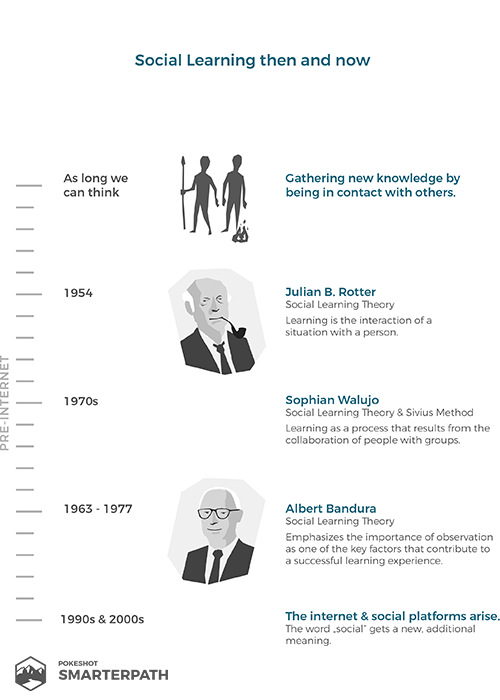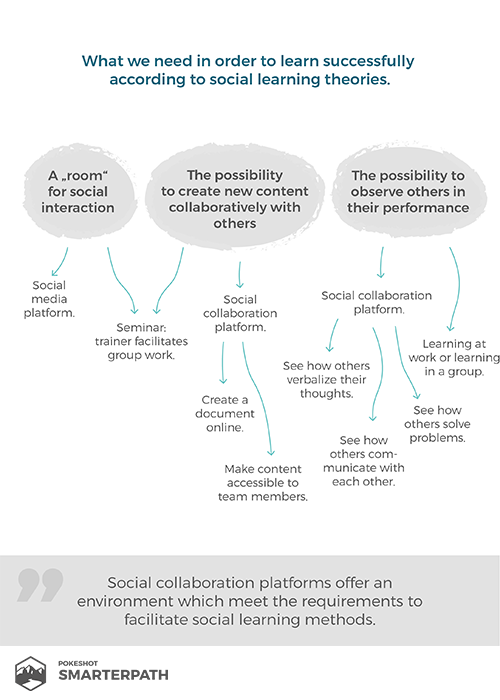Social and informal learning – how it all started.
Learning from and with others is the most natural and intuitive form of acquiring knowledge. It existed long before learning theories, schools and teachers were even invented. However, this informal way of gathering new skills and competencies by being in contact with others, actively collaborating, asking questions and learning-by-doing has recently found its way back into the attention of learning and teaching experts, especially in organizational and corporate contexts.
The broad use of social collaboration platforms such as Facebook (before Facebook there were many regional versions such as StudiVZ in Germany) by the so-called generations Y and Z has brought about a completely new way of communication which follows a very simple rule about human instinct: we want to stay in contact with each other, we want to share, because experiencing something by yourself and not being able to talk about it is simply half the fun, as is knowing something and not being able to share it and get feedback on it.
“Experiencing something by yourself and not being able to talk about it is simply half the fun.”
Combining those two aspects, informal learning and social collaboration, is what many people have been calling “social learning.”
What exactly is Social Learning?
There is no singular, agreed-upon definition of the term “social learning” yet. It is rather the case that it is used within a variety of contexts with various meanings. When defining it, we have to differentiate between two approaches:
“There is no definition of the term SOCIAL LEARNING yet.”
The use of the term when speaking about
- Theories and methods, or
- Providing the right circumstances which facilitate putting those theories into practice.
Social Learning in Terms of Theories and Methods
When we speak about learning theories, “social learning” comes up in several contexts.
Group work
To begin with, the use of group work within a classroom setting has been referred to as social learning. The fact that new knowledge does not only have to be presented but also activated (see our article on “Learning online – what’s all the fuss about?”) and one form of activation is speaking about the new content with peers, asking and answering questions on the topic, can be viewed as a “social” way of learning.
“New knowledge does not only have to be presented but also activated.”
Depending on the task given by the trainer, group work is usually a mixture of guided and informal learning. The involved learners have to solve a certain task and might get some guidance by their trainer on which method to use and they also learn through informal techniques, by interacting with each other and sharing their experiences.
Psychology of Learning
Julian B. Rotter, a learning psychologist, suggested in his Social Learning Theory in 1954 that learning is the interaction of a situation with a person. As opposed to other paradigms which suggest that external stimuli lead directly to a learning outcome, he also took the social context into account.
Another scientist who contributed to what we nowadays know as Social Learning Theory was Sophian Walujo, a Swedish psychologist who defined learning in the 1970s as a process that results from the collaboration of people within groups.
Albert Bandura developed the Social Learning Theory even further (1963 and 1977). By stating that learning is 1) a cognitive process that takes place in a social context, and 2) observing behavior and its consequences, he emphasized the importance of observation as one of the key factors that contributes to a successful learning experience.
Social Learning in Terms of providing the right circumstances
Taking these social learning theories as a foundation, what we need in order to learn successfully is
- a “room” for social interaction,
- the possibility to create new content collaboratively with others,
- the possibility to observe others in their performance.
How can we provide those circumstances?
There are several ways to facilitate an atmosphere which fulfills the requirements above. If we talk about a seminar, the trainer is responsible for giving the learners certain tasks and challenges which are to be solved in a group. In a corporate context, learning from colleagues and managers by observing them is one of the most important forms of learning.
Furthermore, web technology and social media platforms offer some basic characteristics which can fulfill the same requirements in a different form:
-
- a room for social interaction through a social media platform
#Communicate with your team colleagues: in closed “groups”.
#Share content: which is relevant to the respective team.
#Stay informed: ask questions and receive answers by team colleagues.
- a room for social interaction through a social media platform
-
- the possibility to create new content collaboratively with others through a social collaboration platform
#Create a document online, link the people who are involved and ask them to contribute to get the best possible outcome with the shared knowledge of the team.
#Make content accessible to all involved team-members.
- the possibility to create new content collaboratively with others through a social collaboration platform
-
- the possibility to observe others in their performance through a social media platform & a social collaboration platform
#See how colleagues react, their use of phrases and terminology.
#See how colleagues interact with each other or with external stakeholders.
#See how individual and collective know-how is used to make decisions and solve problems.
- the possibility to observe others in their performance through a social media platform & a social collaboration platform
Therefore, social collaboration platforms offer an environment which meets the requirements to facilitate social learning methods. In this sense, social learning can refer both to social learning theories and social media/collaboration platforms.
“Social collaboration platforms offer an environment which meet the requirements to facilitate social learning methods.”


So – What is social learning all about?
In this article we explored the meaning behind the trending term “social learning.” It initially referred to various social learning theories from the 50s, 60s and 70s, decades that pre-date the internet. The term took on additional meaning when social media and collaboration platforms were invented. Not only do they facilitate new ways of communication but they also offer an (online) environment which facilitates the learning processes defined by the social learning theories. For example, they offer room for social interaction, they offer the possibility to observe others in their performance and they offer the possibility to create content collaboratively with others.
What experiences do you have with social learning? Are there examples you can think of? We are looking forward to your comments and thanks for sharing!
About the author

Kerstin Schachinger supports the Pokeshot team as a Workplace Learning Consultant. Combining experiences in adult education in Vienna and Berlin with her enthusiasm for training and her love of creating great content, she found instructional design, facilitating workshops and conducting webinars to be her favorite areas to work in. Kerstin’s linguistic background allows her to break down information and communicate complexity in an easy way, an essential skill when creating learning experiences for a wide variety of target groups.
Connect with us on facebook | twitter | LinkedIn | YouTube – we will keep you posted!